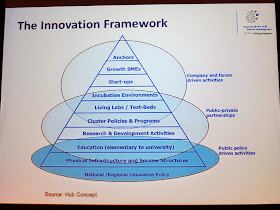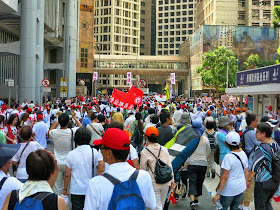Before the symposium, we took a photo with Hon. Charles Mok (Legislative Councillor) in front of symposium poster.
(Left: Dr. Aaron Tong (Managing Director, TQM; Former Chairman of HKSQ), Hon. Charles Mok and I)
In the beginning, Ir. Victor Ng (Chairman of HKETA) gave a welcome speech. Ir. Ng pointed out a question we frequently asked “How Hong Kong’s Technology moving Forward?” and then he thanks for all speakers and panelists, as well as participants.
The first keynote speaker was Hon. Charles Mok (Legislative Councillor) and his presentation topic named “Innovation”. Mr. Mok’s talk included “What’s an innovation?”, “Source of Innovation”, “Rise of Innovation Platforms”, “Innovation Ecosystem”, “Finding core competency” and “Role of Hong Kong Government”.
Innovation had many meaning / definition he said. It included a new idea, a new way to do thing, fulfill a need, technology related, R&D driven, driver for competitiveness, and “The Edge”. Sources of innovation could be changes in industry and market structures, end-user driven, technology enabled, crisis and any difficult situations, asking lots of right questions, as well as, come from the innovators. Then he introduced different platforms included iOS, Android, Facebook, Twitter, AWS, PayPal, etc.
Then he briefed the innovation ecosystem should have entrepreneurs/Talents, Funding and Market. However, it also needed public policy as catalyst. Role of government could be in different way such as Education, R&D support, Financial policies, Support measures and Lead in adoption. The most important was to establish Innovation and Technology Bureau. Finally, Charles concluded the talk in the statement “Reengineering, innovating mindsets!”
Mr. Ricky Wong (Chairman of Hong Kong Television Network) was the second keynote speaker and his presentation entitled “Innovation in Hong Kong”. Mr. Wong shared his fail experience and he had fully demonstrated his persistence and never-give-up spirits with actions on the road of striking for a Free TV licence. He joked that Hong Kong Government had very innovative reasons to reject his application. He shared that innovation was come from pressure. For instance, IDD cost structure changed in 1993. He either shutdown his business or create new idea to run his business that was call-back technology. After application of Free TV license failed, he was exploring business opportunities in E-Commerce, aiming to build the largest and the most diversified in terms of brand names, products & services e-shopping mall in Hong Kong, which provided one-stop shop and 24 x 7 services.
Group Photo
The third speaker was Ir. Allen Yeung (VP, Business Development & Technology Support, HKSTP) and his talk was “Emerging Technology”. Firstly, he introduced 5 Technology Megatrends that prepared by Institute for the Future which was founded in 1968 and their service was using different methodologies to forecast the future, applied to business, government and non-profits organization.
The Five Technology Megatrends included “The Cloud as Supercomputing”, “Material Shifts”, “Robot Renaissance”, “Manipulating Biology” and “Decrypting the Brain”. Then Ir. Allen Yeung said the innovation methodologies trends were citizen science and data-driven discovery that Innovation was able come from everyone and anywhere.
After that Ir. Allen Yeung introduced the innovation framework in which Science Park were implemented. Then he introduced tenant distribution in Science Park where 50x Multinational Corporations (MNCs), 250x SMEs and 150x Incubatees. Science Park would like to nurture future tech giants through Incubation Programme to Acceleration Progamme and finally our tenants to be IPO or M&A. At the end, Allen concluded “Complete Innovation EcoSystem” + “Leverage on Govt & HKSTP’s Support” + “Capitalize on Mega Trends” to be “Unlimited Business Opportunities”.
The fourth speaker was Mr. Matthew Man (Founder and CEO of Myndar) and his presentation title was “Changing Landscape of Retail with Big Data”. Mr. Man introduced why facebook book value US$6.3billion before IPO but increased to US$104 billion of IPO market value. It was because of Intangible Assets “Likes, Posted material and Comments” that were discrete data point (Big Data)!
Mr. Man said Big Data was equal to Transactions plus Interaction plus Observations. It has 3V characteristics that Volume (Data Size), Variety (Data Sources) and Velocity (Speed of Change). Then he introduced the retail technology under big data, Internet of Things (IoT) and Internet of People (IoP). IoT was “Machines can sens, process, exchange information and take action independent of human intervention.” IoP was “People can communicate and access information anywhere.” Lastly, Mr. Man Concluded “A Big-Data Mindset to reveal valuable secrets to make a discovery.”
The fifth speaker was Mr. Fred Sheu (Director, APJ Presales, Enterprise Group, HP) and his topic named “Unlock Insights by Embracing Big Data Analysis”. He briefed the big data definition was high-volume, -velocity and –variety information assets that demanded cost-effective, innovative forms of information processing for enhanced insight and decision making.
Then Mr. Sheu briefed how to use data to get the answer for Clothing, Eatery, Home and Travel (衣食住行). He also said Big Data was for everyone. Moreover, he believed that Big Data would increase business through Foresight, Hindsight and Insight. He also said “Information has become a source of competitive advantage, and organizations risk becoming irrelevant if they can’t harness the power of their Big Data at the speed of business.”
Finally Mr. Sheu introduced HAVEn which was a Big Data platform from HP and ASTRI-HP Information Technology Research Centre which launched on 16 Dec 2013.
Panel Discussion with the topic “How Hong Kong’s Technologies Moving Forward” moderated by Mr. MY Wong (Chairman, ASTRI) and Prof. PC Ching (Professor of EE Dept, CUHK).
(Left: Mr. MY Wong, Prof. PC Ching, Hon. Charles Mok, Ir. Allen Yeung, Mr. Matthew Man and Mr. Fred Sheu)
Charles encouraged changing mindset to think how do we looking at technology. Allen said Science Park’s 5 technology clusters would match the 5 Megatrend. Matthew said to create business close to customer. New technology adoption could create market and user. MY asked Fred how technology of Clothing, Eatery, Home and Travel could be used for elder people? Fred replied simply to make technology easy for use. MY also ask Prof. Ching how to find Data Scientist. Prof. Ching said most of engineering school had statistics training. The most important thing was industry to tell university what type of talent they were looking for.
In restaurant, Mr. Eric Chan (Committee member, HKETA) gave short speech to start the lunch.
During the lunch, Dr. Alfred Ng (Assistant to Managing Director, Suga International Holdings Limited) presented the topic “IoT: New Challenges and Opportunities for Small and Medium-Sized Manufacturing Enterprises”. Dr. Ng explained why the value of normal electronic scale cost HK$200 but fitbit aria Smart Scale (with WiFi & Bluetooth) cost HK$1200. It was the values of being “Smart”!
Then Dr. Ng mentioned knowledge needed for making smart electronics appliances included “Microcontroller Programming, Mechanical Engineering, Circuit Designs, Manufacturing & Quality Control, RF, Cloud, iOS & Android Apps, and Network Security. He found that service needed by Electrical Appliances Makers was the last 5 elements but a service needed by small startup was the first 5 elements.
At the end, Dr. Ng concluded that IoT devices makers required more than just manufacturing services; and barrier to entry IoT can be very low by utilizing cloud services offered by global tech giants.
Reference:
HKETA - http://www.hketa.org.hk/
HKSTP - http://www.hkstp.org/


















































